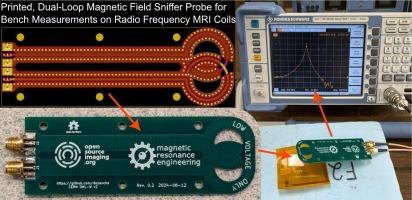Printed, dual-loop magnetic field sniffer probe for bench measurements on radio frequency MRI coils
IF 2.1
Q3 ENGINEERING, ELECTRICAL & ELECTRONIC
引用次数: 0
Abstract
This work describes an open-source design for decoupled dual-loop radio frequency (RF) probes which are common tools in the RF lab. In magnetic resonance (MR) applications dual-loop probes are used to measure the tuning frequency and quality factor of RF coils and associated electronics. Traditional dual-loop probes, however, are delicate and not readily available commercially because they are made using semi-rigid or hand-formable coaxial cable, and they require skill and experience to build well. Our dual-loop probe design is tough, reliable, and can be mass-produced inexpensively, thus allowing new and established labs to obtain these probes with minimal effort. We used two overlapped shielded loops fabricated with multilayer printed circuit board technology. Design files are published under an open-hardware license. The printed probe achieves the required levels of durability and high isolation (better than 50 dB up to 500 MHz) which are equivalent to those achieved with traditional probes, and much more resistant to degradation.

印刷,双环磁场嗅探探头台式测量射频MRI线圈
这项工作描述了一种解耦双环射频(RF)探头的开源设计,这是RF实验室中的常用工具。在磁共振(MR)应用中,双环探头用于测量射频线圈和相关电子器件的调谐频率和质量因子。然而,传统的双环探头很精致,而且不容易在商业上获得,因为它们是用半刚性或手工成型的同轴电缆制成的,而且它们需要技能和经验才能制造好。我们的双环探头设计坚固,可靠,并且可以廉价批量生产,从而允许新的和建立的实验室以最小的努力获得这些探头。我们采用多层印刷电路板技术制作两个重叠的屏蔽回路。设计文件在开放硬件许可下发布。打印探头达到了所需的耐用性和高隔离水平(在500 MHz范围内优于50 dB),这与传统探头所达到的水平相当,并且更耐退化。
本文章由计算机程序翻译,如有差异,请以英文原文为准。
求助全文
约1分钟内获得全文
求助全文
来源期刊

HardwareX
Engineering-Industrial and Manufacturing Engineering
CiteScore
4.10
自引率
18.20%
发文量
124
审稿时长
24 weeks
期刊介绍:
HardwareX is an open access journal established to promote free and open source designing, building and customizing of scientific infrastructure (hardware). HardwareX aims to recognize researchers for the time and effort in developing scientific infrastructure while providing end-users with sufficient information to replicate and validate the advances presented. HardwareX is open to input from all scientific, technological and medical disciplines. Scientific infrastructure will be interpreted in the broadest sense. Including hardware modifications to existing infrastructure, sensors and tools that perform measurements and other functions outside of the traditional lab setting (such as wearables, air/water quality sensors, and low cost alternatives to existing tools), and the creation of wholly new tools for either standard or novel laboratory tasks. Authors are encouraged to submit hardware developments that address all aspects of science, not only the final measurement, for example, enhancements in sample preparation and handling, user safety, and quality control. The use of distributed digital manufacturing strategies (e.g. 3-D printing) is encouraged. All designs must be submitted under an open hardware license.
 求助内容:
求助内容: 应助结果提醒方式:
应助结果提醒方式:


